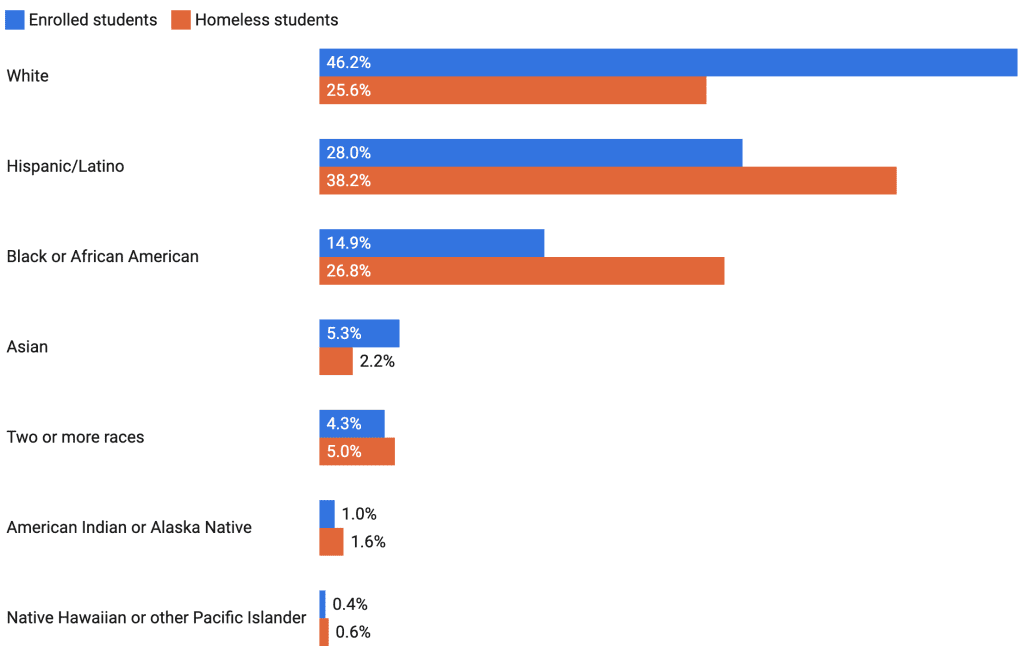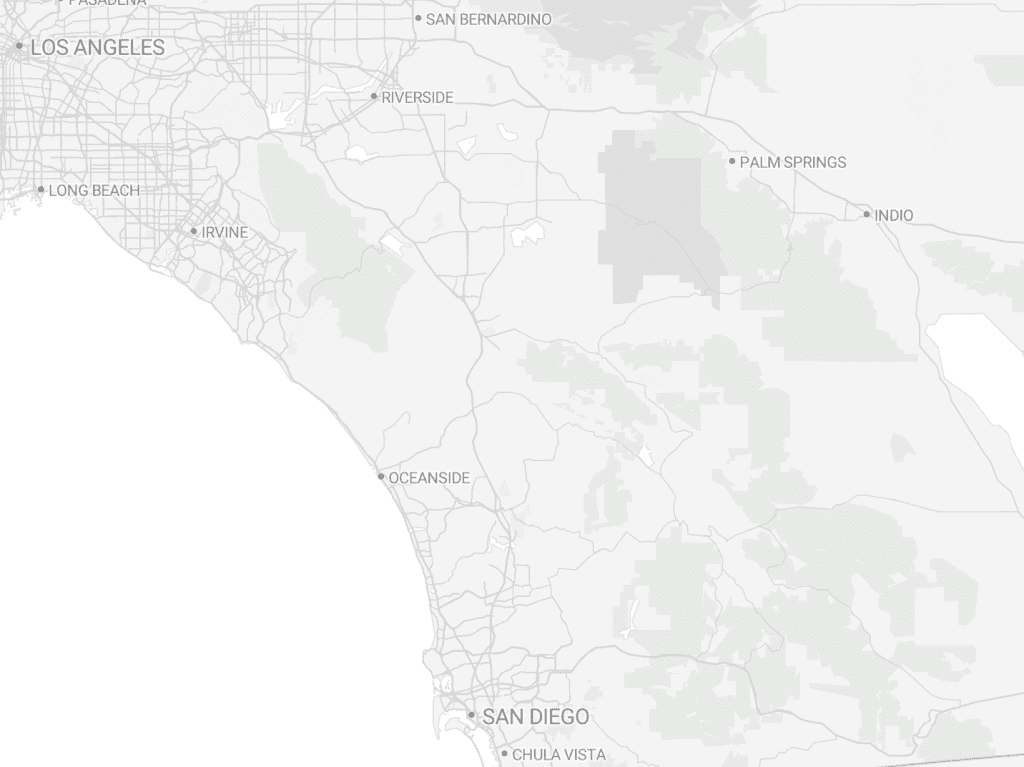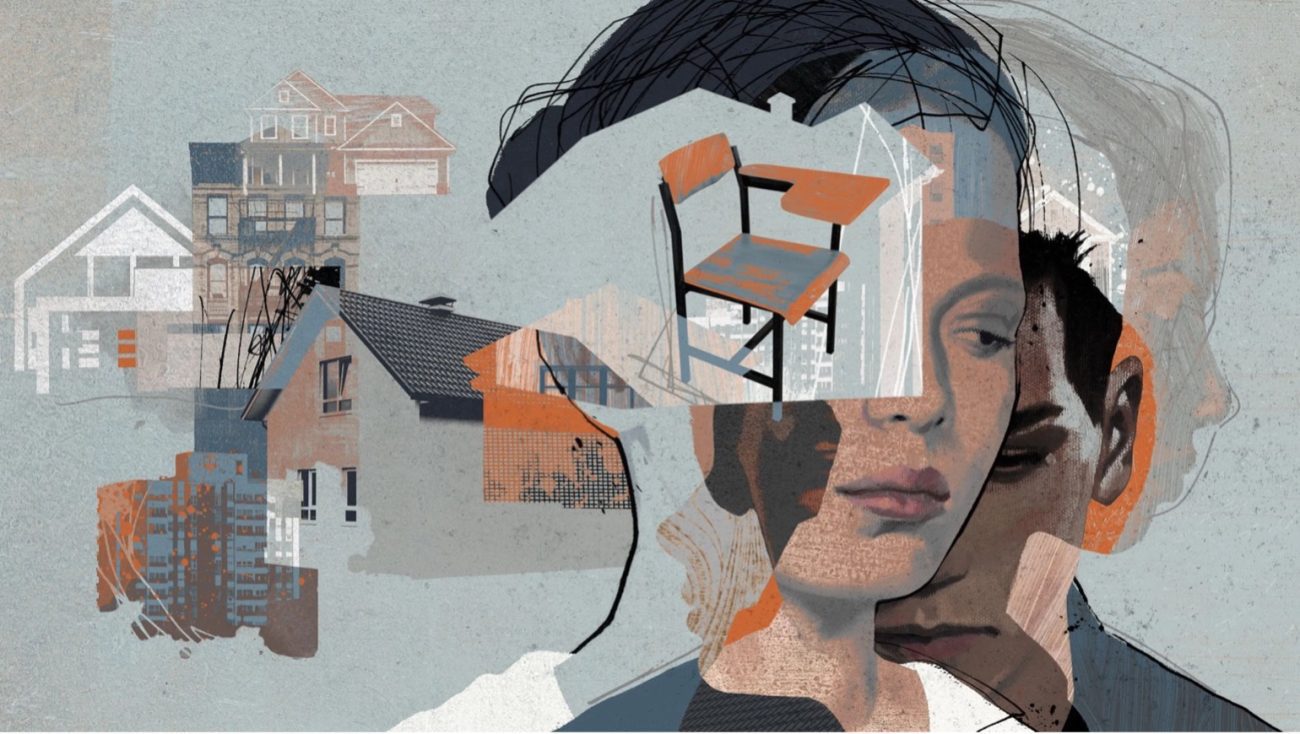Hidden toll: Thousands of schools fail to count homeless students
Chalkbeat National | By Amy DiPierro and Corey Mitchell | November 15, 2022
Federal law promises homeless children an equal shot at education. Many fall through the cracks.
For months, Beth Petersen paid acquaintances to take her son to school — money she sorely needed.
They’d lost their apartment, her son bouncing between relatives and friends while she hotel-hopped. As hard as she tried to keep the 13-year-old at his school, they finally had to switch districts.
Under federal law, Petersen’s son had a right to free transportation — and to remain in the school he attended at the time he lost permanent housing.
But no one told Petersen that.
“They should have been sending a bus for him. … He’s missed so much school I can’t believe it,” Petersen said. “And school is stability.”
A Center for Public Integrity analysis of district-level federal education data suggests roughly 300,000 students entitled to essential rights reserved for homeless students have slipped through the cracks, unidentified by the school districts mandated to help them.
Some 2,400 districts — from regions synonymous with economic hardship to big cities and prosperous suburbs — did not report having even one homeless student despite levels of financial need that make those figures improbable.
And many more districts are likely undercounting the number of homeless students they do identify. In nearly half of states, tallies of student homelessness bear no relationship with poverty, a sign of just how inconsistent the identification of kids with unstable housing can be.
The reasons include a federal law so little-known that people charged with implementing it often fail to follow the rules; nearly non-existent enforcement of the law by federal and state governments; and funding so meager that districts have little incentive to survey whether students have stable housing.
“It’s a largely invisible population,” said Barbara Duffield, executive director of SchoolHouse Connection, a Washington, D.C.-based nonprofit focused on homeless education. “The national conversation on homelessness is focused on single adults who are very visible in large urban areas. It is not focused on children, youth and families. It is not focused on education.”
Losing a home can be a critical turning point in a child’s life. That’s why schools are required to provide extra support.
Nationwide, homeless students graduate at lower rates than average, blunting their opportunities for stable jobs and increasing the risk of continued housing insecurity in adulthood.
The gap is often stark: In 18 states, graduation rates for students who experienced homelessness lagged more than 20 percentage points behind the overall rate in both 2017 and 2018.
The academic cost is not equally shared. Black and Latino children experience homelessness at disproportionate rates, Public Integrity’s analysis showed. Nationally, American Indian or Alaska Native students were also over-represented, as were students with disabilities.
Until recently, it was not clear from federal records which students were hit hardest by housing instability. Data disclosed in U.S. Department of Education reports revealed nothing about the race or ethnicity of students recognized by their school districts as homeless.
That changed in the 2019-20 school year when the federal government for the first time made public the race and ethnicity breakdowns for individual school districts. The pattern that emerged is a story of the country’s sharp inequities, which put some families at far higher risk of homelessness than others.
The McKinney-Vento Homeless Assistance Act, first enacted in 1987 and expanded in 2001, requires that districts take specific actions to help unstably housed students complete school. Districts must waive enrollment requirements, such as immunization forms, that could keep kids out of the classroom. They must refer families to health care and housing services. And they must provide transportation so children can remain in the school they attended before they became homeless, even if they’re now outside the attendance boundaries.
Earl Edwards, an assistant professor at Boston College’s School of Education and Human Development, argues that McKinney-Vento was premised on an idea still pervasive in the policy debate on homelessness: Like a tornado that levels towns at random, housing misfortune has an equal chance of afflicting anyone, regardless of who they are.
In the 1980s, that rhetoric was a potent argument in favor of expanded federal support for homeless services. It was also wrong.
The McKinney-Vento Act started as an inadequate policy
The McKinney Act — later renamed — took shape at a time when the Reagan administration, if it acknowledged homeless people at all, regarded them as having chosen a life on urban skid rows, said Maria Foscarinis, who helped write the law.
Foscarinis, the founder of the National Homelessness Law Center, reframed homelessness as a broader structural problem impacting families, people of all races, even suburbanites. The outcome was a race-neutral solution, despite data at the time that went counter to that theory.
Foscarinis said the law’s architects knew it was inadequate and planned to follow it with homeless prevention programs and housing. But they faced stiff resistance. It would have been better to include race-conscious language tracking the demographics of homeless children, she added, but doing so could have jeopardized the entire effort.
“Had we done that, it would have torpedoed the whole thing, which would have hurt Black communities even more,” she said. “Then, we would have nothing at all.”
Figures now available down to the school district show the consequences of homelessness policy that doesn’t address race directly.
Nationally, Black students were 15% of public school enrollment but 27% of homeless students in 2019-20. In 36 states and Washington, D.C., the rate of homelessness among Black students was at least twice the rate of all other students that year.
Boston College’s Edwards said the disconnect lies between the reality of housing inequality and the policies intended to address it.
“If you don’t recognize that Black people, during the time when you were establishing the actual policy, were disproportionately experiencing homelessness” — and that housing discrimination, urban renewal, blockbusting and other systemic factors pushing Black people out of housing were key drivers — “then you make a policy, and the policy doesn’t have anything in place to prevent those things from persisting,” Edwards said.
And under-identification of homelessness could impact Black students more than peers of other races.
In interviews with Black students who experienced homelessness while enrolled in Los Angeles County public school districts, Edwards found that many distrusted school personnel, who underestimated their academic ability, sent them to the principal’s office for the smallest perceived slights, and threatened to call child protective services.
Race and homelessness in public schools
Black and Latino children were particularly over-represented among students identified as homeless nationwide in the 2019-20 school year, a reflection of the country’s longstanding economic inequality.

Chart: Amy DiPierro, Center for Public Integrity Source: National Center for Homeless Education analysis of Department of Education data
As a result, Edwards found, many students went unidentified under McKinney-Vento because they feared that sharing their situation would only make things worse. They paid for transit passes out of pocket. They were forced out of their home districts. They navigated college admissions alone. If they were lucky, they found mentors outside of the school system.
Those experiences aren’t an accident, Edwards argues, but the product of historical patterns. For example: “Calling child protective services would not be a severe threat to Black students if racial disparities within the institution itself were less pronounced.”
Beneath the race-neutral veneer of McKinney-Vento, American Indian or Alaska Native students and Latino students also experience housing instability at higher rates than their peers in the majority of states.
In Capistrano Unified, a 44,000-student school district in southern California, the rate of homelessness among Latino students was roughly 24% in recent school years compared to about 2% among the rest of the student body.
“It’s not anything that we’ve really done research on, so I wouldn’t even be able to speculate” as to why, said Stacy Yogi, executive director of state and federal programs for the district.
Across California, Latino students are 56% of public school enrollment but 74% of homeless students.
A 2020 report from the University of California, Los Angeles, found that Black and Latino students who experience homelessness in the state are more than one and a half times as likely to be suspended from school as their non-homeless peers. They also miss more school days and are less prepared for college.
Public Integrity’s analysis also found that students with disabilities have higher rates of homelessness than the rest of their peers in every state except Mississippi, suggesting that a significant share of students who already require additional support attend school uncertain of where they will sleep that night.
“They’re experiencing trauma, and trauma has a pretty significant impact,” said Darla Bardine, executive director of the National Network for Youth, a policy and advocacy group focused on youth homelessness. “You have to navigate an overly complicated system, and it’s this competition for limited resources where young people and children and families are just inherently disadvantaged.”
Students with disabilities facing homelessness
Children with disabilities made up a greater share of homeless students in the 2019-20 school year than among the total student population.

Chart: Amy DiPierro, Center for Public Integrity Source: National Center for Homeless Education analysis of Department of Education
EJ Valez, who has limited vision and requires large-print materials for reading and braille instruction, was among them.
Valez experienced housing instability for most of his youth, bouncing between homes and schools in the Bronx and Reading, Pennsylvania.
“I’m surprised I made it out of school,” he said.
As a teenager, he said, he couch-surfed with friends and acquaintances after he became estranged from his family.
“Somehow I could retain information, but at no point in my childhood before full-on adulthood was there ever actual stability,” said Valez, now a student at Albright College in Pennsylvania and a member of the National Network for Youth’s National Youth Advisory Council. “No one cares about classes if we don’t know where we’re going to put our heads at night.”
That, he said, is why extra help from schools is so critical.
Hidden homelessness in America
It might seem like common sense to assume that where more children experience poverty, more will experience homelessness, too.
But that’s not what the data from school districts show. One of the most surprising patterns we found is that reported homelessness among students didn’t mirror poverty in 24 states.
The finding runs counter to a growing body of empirical evidence supporting the connection between poverty and housing instability. Children born below 50% of the poverty line had a higher probability of eviction than higher-income peers, lower-income households are more likely to experience forced mobility, and renters who are forced to move end up in higher-poverty neighborhoods than renters who move voluntarily.
“There should be a stronger relationship between homelessness and poverty,” said Jennifer Erb-Downward, director of housing stability programs and policy initiatives at the University of Michigan’s Poverty Solutions, “and the fact that there’s not supports that there’s under-identification taking place.”
Districts can tell teachers and staff to look for common signs of housing instability among students — fatigue, unmet health needs, marked changes in behavior. But those aren’t always apparent.
If they’re following the law, districts will survey families so they can self-identify as homeless. But some parents fear that acknowledging their housing struggles could prompt the government to take their kids away.
And then there’s the gulf between what people commonly think of as homeless and the more expansive definition Congress uses for students. Living in a shelter, on the streets, in a vehicle or in a motel paid for by the government or a charitable organization are included, but that’s not all.
More than 70% of children eligible for services were forced by economic need to move out of their homes — with or without their family — and in with relatives or friends, a practice that the U.S. Department of Education defines as “doubled up.”
Research on doubled-up students shows there’s good reason to provide them with help: They earned lower grades, for example, and were less likely to graduate on time.
In Riverside County, California, Beth Petersen’s son met the definition of doubled up for months, having lived temporarily with her sister and with friends.
Only Petersen didn’t know it at the time.

Eventually, the two found housing outside the Temecula Valley Unified School District her son had attended for years. He switched districts, keeping up with the schoolwork but struggling to make friends.
Then a friend of Petersen’s who works at a charter school told her that her son had the right to re-enroll in the Temecula Valley schools because the McKinney-Vento law allows students to stay in the same school they attended before becoming homeless.
In early September, Petersen moved with her son into a two-bedroom apartment — still outside the district boundaries — paid for by a homeless prevention organization and shared with another family. Under federal law, her son is considered homeless because they live in transitional housing.
Petersen re-enrolled her son in Temecula Valley Unified but problems persisted. She said she pleaded with the district for weeks, trying to secure bus rides for the teenager. The district never responded to her emails, she said. He ultimately missed a month of classes, Petersen estimated, because she could not afford to continue paying acquaintances to transport her son every day.
The California Department of Education intervened in late September to ensure her son received transportation.
“This has been a teachable moment for the district and there are protocols and … barriers that have been removed to ensure the law is met,” an employee at the state agency wrote Petersen in an email.
A statement provided by Temecula Valley Unified in response to detailed questions regarding the Petersens said the district “does everything in its power to support our McKinney-Vento families experiencing homelessness” and has “highly responsive site and district teams,” but declined to comment further.
Experts think students like Petersen’s son are among those most likely to go unidentified and unassisted because their families don’t realize they qualify for help and schools too often fail to fill the information gap.
When that happens, “we’re not even including most of our kids who are experiencing homelessness in the definition of who’s homeless,” said Charlotte Kinzley, supervisor of homeless and highly mobile services for the Minneapolis Public Schools. “So we haven’t even named the problem.”
In Minneapolis, the reported graduation rate for homeless students is at least 26 percentage points below the rate for all students. The district introduced programs in the last few years to help schools find more students experiencing housing instability and connect them with assistance. Lesson plans for teachers help high school students understand if they qualify.
Across Minnesota, districts generally reported homeless rates that loosely mirrored trends in free- or reduced-price lunch eligibility, suggesting some consistency in identification.
“It’s not a matter of getting the right count or getting the numbers,” said Melissa Winship, a Minneapolis schools counselor who works with students experiencing homelessness. “It’s a matter of those students and families having those supports and resources that they deserve.”
Data on student homelessness is collected by districts and funneled to the federal government by states, which can choose to leave out any districts that did not report having any homeless students. Our data adds those excluded districts back. We assume they identified no homeless students, since they’re not in federal data.
Our analysis focused on non-charter districts in the 2018-19 and 2019-20 school years. In addition to comparing poverty and reported homelessness, we applied a common benchmark used by education researchers and some public education officials — that one of every 20 students eligible for free- or reduced-price lunches experience homelessness under the federal definition.
In each school year we analyzed, more than 8,000 districts did not meet the one-in-20 guideline.
DeSoto County, Mississippi, for instance, identified fewer than 300 homeless students, according to state records Public Integrity reviewed. Its share of students eligible for free- or reduced-price lunches suggests the district has three times the number it reported.
That’s not the only reason to suspect an undercount. In 2018, local landlords filed more than 4,000 eviction cases, according to an estimate from Princeton University’s Eviction Lab.
By comparison, Mississippi’s Vicksburg Warren School District identified about as many homeless students as DeSoto despite having less than half as many children eligible for free- or reduced-price lunches.
The DeSoto County schools did not respond to requests for comment.
It’s possible that some school districts genuinely have fewer homeless students than this benchmark predicts. But multiple researchers told us that they see the one-in-20 threshold as a conservative estimate.
J.J. Cutuli, a senior research scientist at Nemours Children’s Health System, said the analysis bolsters the anecdotal experiences of school district staff, shelter personnel, and people who’ve lived through periods of homelessness.
“You’re giving us a clue as to the magnitude of this problem. And that’s really the important part here,” he said.
The University of Michigan’s Erb-Downward said the reason numbers are critical is because “we, somehow, as a society, have agreed that it is OK for the level of poverty and instability that children experience, from a housing perspective, to exist.”
“If we don’t actively track that, and have a conversation about what the level [of homelessness] really is, I don’t think we’re being forced to actually look at that decision that we’ve made societally,” she said. “And we’re not really being forced to say, ‘Is this actually what makes sense? Is this actually what we want?’”
Why tracking homeless children in America is an ‘uphill battle’
The federal government, state education departments, and families have few options to hold districts accountable if they fail to properly identify or provide assistance for students experiencing homelessness.
The U.S. Department of Education delegates enforcement to states. States where school districts fail to follow the law are subject to increased monitoring, but the federal agency would not say how often that happens. A spokesman said only that the agency “engages in monitoring and compliance activities that can include investigating alleged non-compliance.”
Public Integrity reviewed dozens of lawsuits in which families and advocacy groups alleged that school districts denied students rights that are guaranteed under the federal McKinney-Vento law.
Families experiencing homelessness have sometimes prevailed in their standoffs with education agencies, winning reforms like agreements to train school personnel in the law and, in one case, a toll-free number for parents and children to contact with questions about their rights.
“There’s not really a ton of capacity for actually investigating and dealing with these complaints,” said Katie Meyer Scott, senior youth attorney at the National Homelessness Law Center. “We have a problem where there’s not necessarily an investment in enforcement at either the federal or state level.”
As an extreme last resort, the U.S. Department of Education can cut funding — a step officials are loath to take because that would ultimately harm the very students the agency wanted to help. The agency said it has never penalized a state in this manner.
A 2014 investigation by the Government Accountability Office found that eight of the 20 school districts its staff interviewed acknowledged they had problems identifying homeless students. The watchdog agency found that the U.S. Department of Education had “no plan to ensure adequate oversight of all states,” with similar gaps in state monitoring of school districts.
State audits in California, Washington, and New York have also made the case that many school districts fail to identify a significant number of students who qualify for the rights guaranteed under federal law. Advocacy groups and researchers, too, have surfaced examples.
In Michigan, state Department of Education guidelines call for an investigation if school districts identify fewer than 10% of low-income students as homeless. Erb-Downward found that all but a handful of Detroit schools fell below this threshold in the 2017-18 school year.
Public Integrity’s analysis points to similar problems. Detroit’s public school district, the largest district in the state, identified 255 fewer homeless students than the Kalamazoo Public Schools in 2018-19, despite having four times as many students and a much higher poverty rate.
Detroit school superintendent Nikolai Vitti said in a statement that the district’s efforts to improve in recent years include adding full-time staff to its homeless student office, a residency questionnaire with its student enrollment form, referral systems, and public information about available services.
Homeless student numbers have tripled in the past several years, Vitti said. But, he added, “We are aware there is still an undercount.”
A statewide review this year identified 120 Michigan school districts, roughly 20%, in need of additional monitoring, department spokesman Martin Ackley said. The state is asking those districts to provide evidence that they are in compliance with federal law.
The state expects to finish the reviews this winter and will provide technical support to districts struggling to meet federal requirements.






